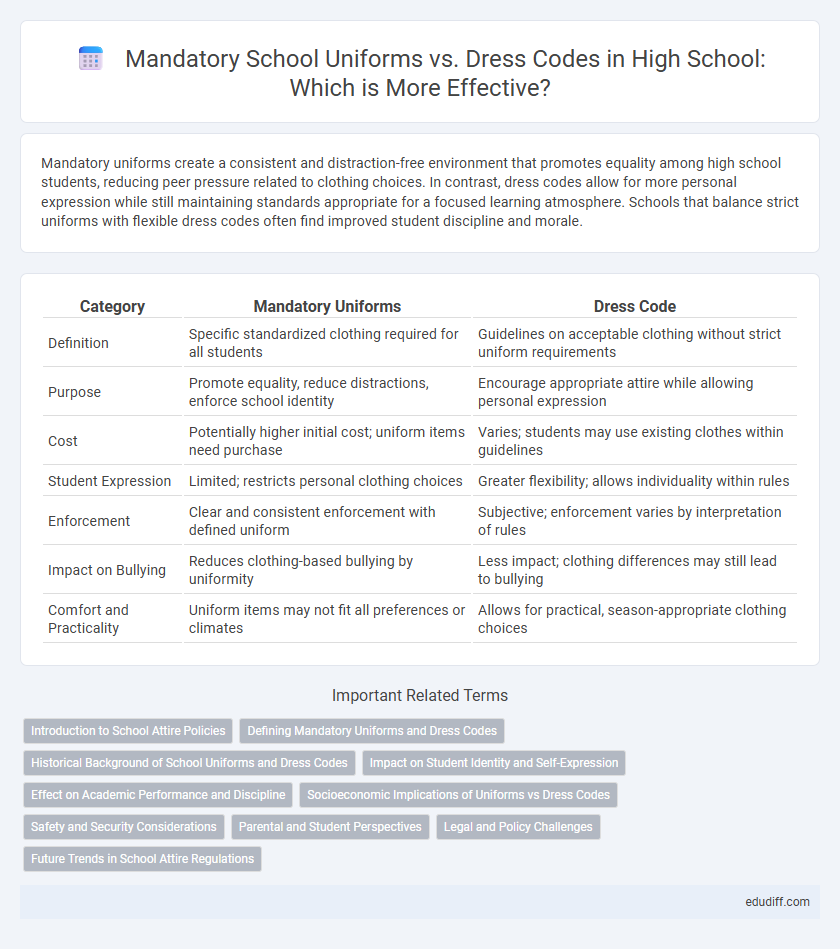Mandatory uniforms create a consistent and distraction-free environment that promotes equality among high school students, reducing peer pressure related to clothing choices. In contrast, dress codes allow for more personal expression while still maintaining standards appropriate for a focused learning atmosphere. Schools that balance strict uniforms with flexible dress codes often find improved student discipline and morale.
Table of Comparison
| Category | Mandatory Uniforms | Dress Code |
|---|---|---|
| Definition | Specific standardized clothing required for all students | Guidelines on acceptable clothing without strict uniform requirements |
| Purpose | Promote equality, reduce distractions, enforce school identity | Encourage appropriate attire while allowing personal expression |
| Cost | Potentially higher initial cost; uniform items need purchase | Varies; students may use existing clothes within guidelines |
| Student Expression | Limited; restricts personal clothing choices | Greater flexibility; allows individuality within rules |
| Enforcement | Clear and consistent enforcement with defined uniform | Subjective; enforcement varies by interpretation of rules |
| Impact on Bullying | Reduces clothing-based bullying by uniformity | Less impact; clothing differences may still lead to bullying |
| Comfort and Practicality | Uniform items may not fit all preferences or climates | Allows for practical, season-appropriate clothing choices |
Introduction to School Attire Policies
School attire policies, including mandatory uniforms and dress codes, establish standards for student appearance to promote discipline and reduce distractions. Mandatory uniforms require specific clothing items, fostering unity and minimizing socioeconomic disparities among students. Dress codes offer flexible guidelines focused on appropriateness and safety while allowing personal expression within defined limits.
Defining Mandatory Uniforms and Dress Codes
Mandatory uniforms in high schools require all students to wear specific clothing items designed by the institution, ensuring uniformity and minimizing distractions. Dress codes set general guidelines on appropriate attire, allowing more flexibility while prohibiting disruptive or inappropriate clothing. Both policies aim to create a conducive learning environment but differ in strictness and student expression.
Historical Background of School Uniforms and Dress Codes
School uniforms date back to 16th century England, originally designed to reflect social order and promote discipline among students, while modern dress codes evolved later to offer more flexibility and accommodate diversity. Uniforms became prominent in the early 20th century as a means to reduce peer pressure and create equality, contrasting with dress codes that focus on appropriateness and individual expression. Historical shifts reveal uniforms as tools for unity and discipline, whereas dress codes emphasize behavioral guidelines within educational environments.
Impact on Student Identity and Self-Expression
Mandatory uniforms in high schools promote a sense of equality and reduce distractions but can limit students' ability to express their individuality and personal style. Dress codes offer more flexibility, allowing students to showcase their identity while maintaining standards of appropriateness. The balance between uniforms and dress codes significantly influences students' comfort, confidence, and social dynamics within the school environment.
Effect on Academic Performance and Discipline
Mandatory uniforms in high schools are linked to improved academic performance by minimizing distractions and fostering a focused learning environment. Uniform policies contribute to enhanced discipline, reducing behavioral issues and promoting a sense of equality among students. In contrast, dress codes allow more personal expression but may lead to inconsistencies in enforcement and potential distractions that could impact student concentration and classroom order.
Socioeconomic Implications of Uniforms vs Dress Codes
Mandatory school uniforms help reduce visible socioeconomic disparities among students by standardizing attire and minimizing peer pressure related to fashion brands. Dress codes, while offering more flexibility, can inadvertently highlight economic differences as students' clothing choices may reflect their family's financial status. Uniforms promote a more equitable environment by limiting opportunities for economic-based discrimination and social stratification within the school community.
Safety and Security Considerations
Mandatory uniforms in high schools enhance safety and security by enabling quick identification of students and preventing outsiders from accessing campus unnoticed. Dress codes, while allowing more personal expression, may create ambiguity in enforcement and increase risks related to inappropriate attire or gang-related clothing. Uniform policies reduce distractions and conflicts, promoting a safer and more focused learning environment.
Parental and Student Perspectives
Parents often prefer mandatory uniforms for high schools due to their potential to reduce peer pressure and create a sense of equality among students. Many students, however, favor flexible dress codes that allow for personal expression and comfort while still maintaining appropriate standards. Both perspectives highlight the balance between fostering a disciplined environment and respecting individual identity in educational settings.
Legal and Policy Challenges
Mandatory uniforms in high schools often face legal challenges concerning students' rights to freedom of expression under the First Amendment, prompting courts to balance these rights against schools' interests in promoting discipline and equality. Dress code policies, while generally more flexible than uniform mandates, still encounter disputes over vague language and potential discrimination based on gender, religion, or cultural practices, raising compliance issues with Title IX and the Equal Protection Clause. School districts must navigate evolving legal precedents and state-specific regulations to implement policies that uphold educational goals without infringing on constitutional rights.
Future Trends in School Attire Regulations
Future trends in school attire regulations reveal a shift toward hybrid models combining mandatory uniforms with flexible dress codes, allowing students limited personal expression while maintaining school identity. Technological advancements enable smart fabrics and customizable uniforms that adapt to weather and activity, promoting comfort and practicality. Increasing emphasis on inclusivity drives policies accommodating cultural, gender, and body diversity, reflecting broader societal movements within high school clothing standards.
Mandatory Uniforms vs Dress Code Infographic

 edudiff.com
edudiff.com